Shelving Books BackwardThe New 50 Shades of Grey (or Tan)by Craig Stark #180 28 May 2019 |
I've put this off as long as I could. For a few years now there's been a growing trend to shelve books backwards - and it's become epidemic, especially on TV shows that focus
on home decor. Some contend that Joanna Gaines of Fixer Upper is the queen of backwards book shelving if not its evil originator.
For the most part I've always considered myself a function-first-form-later kind of guy. My thinking has been that, if form dominates function, there comes a point at which function
ceases to be functional; whereas, if function is given first billing, there's much less danger of something becoming dysfunctional. There's also a school of thought which asserts that,
if function ever reaches a level that can't be improved upon, form may be ignored altogether because perfect function necessarily possesses beauty, often because it emulates something
in nature. My purpose here isn't to argue one way or another but to discuss, hopefully with some objectivity, how this impacts books.
The first question that arises in my mind is, "What's the point of shelving books backward?" If you have many books at all, surely it would make it difficult to locate a book or two you
might be looking for. Which of course begs the question: If you have lots of books but can't without much difficulty find them readily, do you just not care about reading books? To put
it differently, do you look upon books only as decoration? If so, I suppose a case could be made for celebrating a view from the back. With some exceptions text block fore edges mostly
range from white to tan, so there's a sort of uniformity of color going on. For some decades interior decorators have often shelved books spines out, with or without dust jackets, on
the basis of color. To me this seems most effective with books in the white/tan range, perhaps blue, as in shabby chic contexts. And I'm not forgetting that texture is in play here. There
are many variations in fore-edge textures, not to mention at least minimal color on the exposed fore edges of bindings.
As with so many other things, "nihil novi sub sole" (Ecclesiastes 1:9) - or, "there is nothing new under the sun." Yes, there is longstanding precedence for backwards shelving. Centuries
ago monasterial books were chained to shelves to prevent, among other things, theft. For primarily utilitarian reasons (think in terms of pulling a book out and draping the chain somewhere
out of the way), they were usually oriented fore edge out, sometimes locked. Henry Petroski discusses this at length in his The Book on the Bookshelf. [Editor's note: See a BookThink interview
with him here.
For that matter, printing titles on spines is, after all, a relatively new practice. But let's get back to current practice. Many have their theories on why this is done so much today.
An interior designer might believe that backwards shelving presents a clean, modern look, utility be damned. The trifecta of minimalism, neutrality and uniformity are high on the
decorator's priority list these days. No doubt that books shelved spine out can "age" a room instantly. Moreover, not all books display well spine out, especially more modern books without
dust jackets. Perhaps I should also mention that, in this context, fore edge painting, the type that doesn't require page fanning to view, could theoretically look pretty darn good on a shelf:
Of course, it isn't easy to come up with things like this during a renovation. The cynic in me guesses that interior designers have at least some less-than-noble motive in backwards
shelving. Faced with a tight-budgeted renovation that involves an existing wall of shelving and a deadline, costs can be kept down by not tearing it out and simply filling all or part
of it with ugly, low-cost books that become not quite so ugly if shelved backwards. Seems almost shiftless, if true. In any case, for the time being backwards shelved books are at least
an attention getter. But let me take a guess here: Five or ten years from now we won't be seeing this on TV anymore, not to mention barn doors, pillow chops, subway tile - oh, and and
ship lap. And did I mention grey walls? It is a trend, after all, and if nothing else people will soon tire of dusting dust-collecting fore edges. And don't forget that dust left to the
elements can soon morph into something that looks an awful lot like foxing on fore edges:
Ugly!
As a bookseller, I will say that this shelving method does protect book and dust jacket spines from fading, but other than that, there's not much for me to get excited about. If
you're going to mess around with books during a renovation, why not do something mildly interesting. Altered books, for example. Or book fans:
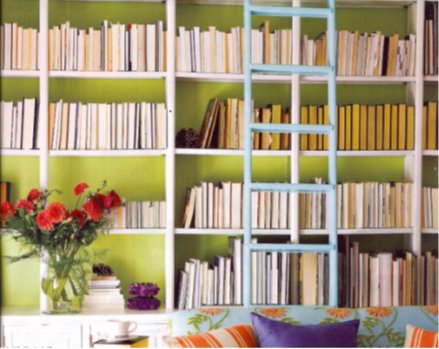
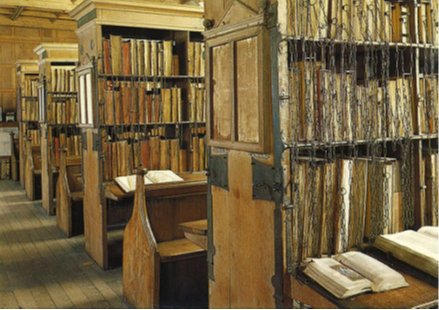
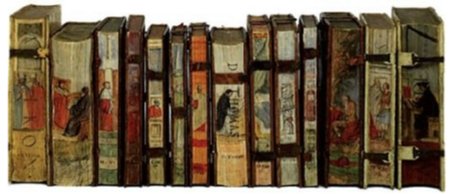
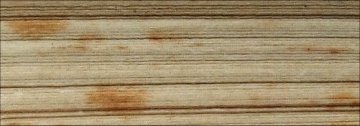
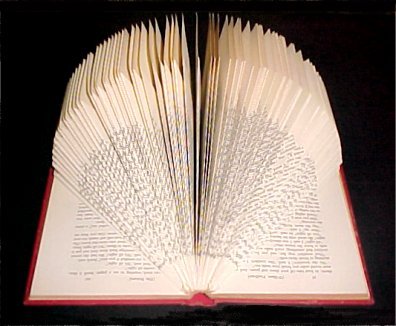
Copyright 2003-2018 by BookThink LLC